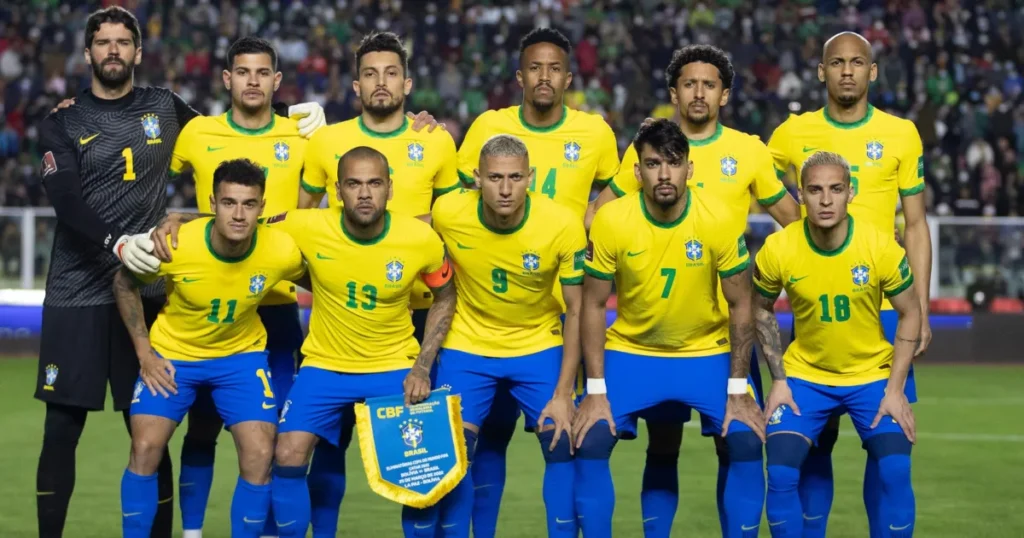When you think of football, the image of yellow jerseys dancing across the pitch with effortless flair often comes to mind. That’s the Brazil national football team – the Seleção, as they’re affectionately known – a squad that has redefined the beautiful game for generations. As the most successful national team in FIFA history, Brazil’s football team isn’t just about wins; it’s about artistry, resilience, and a cultural heartbeat that pulses through every match. Whether you’re a die-hard fan tracking the latest Brazil FIFA ranking or a newcomer curious about Brazil’s next match, this deep dive into their world will leave you buzzing with excitement. From their storied past to the electric fan culture that makes every game a festival, let’s lace up and explore what makes this team legendary.
The Rich History of the Brazil Football Team
The Brazil football team didn’t just emerge as a powerhouse; they evolved through triumphs, heartbreaks, and sheer innovation. Founded in 1914 by the Confederação Brasileira de Futebol (CBF), Brazil’s national side played their first official international match in 1914 against Argentina, ending in a 3-3 draw. But it was the 1930s and 1940s when the team began to shine on the global stage, winning their first Copa América in 1919 and repeating the feat multiple times.
The real golden era kicked off in the 1950s. The infamous Maracanazo of 1950 – that gut-wrenching 2-1 loss to Uruguay in the World Cup final at Rio’s Maracanã Stadium – scarred the nation but ignited a fire. It led to a complete overhaul, birthing the 4-2-4 formation that revolutionized football. By 1958, a teenage Pelé lit up Sweden, scoring six goals as Brazil claimed their first Jules Rémé trophy. That victory wasn’t just a win; it was a coronation. The 1962 World Cup in Chile followed suit, with Garrincha taking the spotlight amid injuries to Pelé, proving Brazil’s depth.
The 1970s cemented their dominance. The 1970 tournament in Mexico is often hailed as the greatest World Cup ever, with Pelé, Jairzinho, and company dazzling in a side that played like poets. They won every match, scoring 19 goals and conceding just three. Fast-forward to the 1990s, and Romário’s predatory instincts led to a fourth star in 1994 on American soil. The 2002 triumph in Japan and South Korea, under Ronaldo’s lethal finishing, added a fifth – a record that still stands.
Through military dictatorships, economic upheavals, and social changes, the Brazil football team has mirrored the country’s spirit: vibrant, unyielding, and always entertaining. Today, as they navigate modern challenges, their history reminds us why they’re not just a team, but a movement.
Major Achievements: Why Brazil’s Football Team Stands Alone
No conversation about the Brazil national football team is complete without tallying their trophies – a collection that dwarfs every other nation. With five FIFA World Cup titles (1958, 1962, 1970, 1994, 2002), Brazil holds the record and has qualified for every single edition since 1930. That’s 22 straight appearances, a testament to their consistency.
In the Copa América, they’ve lifted the trophy nine times (1919, 1922, 1949, 1958, 1963, 1997, 1999, 2004, 2007), more than any other country. Their flair extends to the FIFA Confederations Cup, won three times (1997, 2005, 2009), and they’ve claimed Olympic gold in 2016 and 2020, ending a long drought in major youth tournaments.
But numbers only tell part of the story. Brazil’s achievements include pioneering total football before it had a name, producing 11 Ballon d’Or winners (more than any other country), and holding the all-time record for most international goals (over 5,000). Their Brazil FIFA ranking has fluctuated – dipping to as low as 18th in 2014 after a humiliating 7-1 semifinal loss to Germany – but they’ve bounced back, often hovering in the top five. These milestones aren’t just hardware; they’re chapters in a saga of excellence that inspires billions.
To give you a clearer snapshot of their dominance, here’s a handy table summarizing key World Cup performances. This breakdown helps underscore how the Brazil football team has shaped tournament history, from goal tallies to iconic moments.
| Year | Host Country | Matches Played | Wins | Draws | Losses | Goals For/Against | Final Position | Key Highlight |
|---|---|---|---|---|---|---|---|---|
| 1950 | Brazil | 6 | 5 | 0 | 1 | 22/5 | Runner-up | Maracanazo heartbreak vs. Uruguay |
| 1958 | Sweden | 6 | 5 | 1 | 0 | 16/2 | Champions | Pelé’s debut explosion (6 goals) |
| 1962 | Chile | 6 | 4 | 2 | 0 | 14/5 | Champions | Garrincha’s magic amid Pelé injury |
| 1970 | Mexico | 6 | 6 | 0 | 0 | 19/7 | Champions | Perfect run; “Team of the Century” |
| 1994 | USA | 7 | 5 | 2 | 0 | 11/3 | Champions | Romário’s 5 goals; penalty shootout win |
| 2002 | Japan/S. Korea | 7 | 7 | 0 | 0 | 18/4 | Champions | Ronaldo’s 8 goals; “3 Rs” trio shines |
| 2014 | Brazil | 6 | 3 | 0 | 3 | 10/14 | Semifinals (4th) | 7-1 Mineirazo loss to Germany |
| 2022 | Qatar | 5 | 3 | 1 | 1 | 8/3 | Quarterfinals | Neymar’s return but Croatia exit |
This table not only highlights their five stars but also illustrates resilience – even in setbacks like 2014, they’ve rebounded stronger. It’s a visual roadmap of why Brazil’s football team remains the benchmark.
Iconic Key Players: Legends Who Defined the Seleção
The Brazil national football team is synonymous with its stars, players who transcend the sport. Pelé, the King, scored 1,281 goals in his career, including 77 for Brazil, and his three World Cups are unmatched. Then there’s Garrincha, the “Little Bird,” whose dribbling was pure joy – he carried 1962 almost single-handedly.
The 1970s brought Falcão and Zico, midfield maestros whose vision and passing set new standards. Fast-forward to the 1990s: Romário’s ice-cold finishing in 1994 and Ronaldo’s blend of power and skill in 2002 (becoming the tournament’s top scorer with eight goals). Ronaldinho added magic in the 2000s, his no-look passes and free-kicks a highlight of the 2002 win.
Modern eras spotlight Neymar, the flamboyant forward whose 79 goals for Brazil (as of late 2025) make him the all-time second-highest scorer. His creativity echoes the old guard, though controversies have shadowed his brilliance. Alongside him, Vinícius Júnior’s explosive pace and Ederson’s goalkeeping precision represent the new wave. Goalkeepers like Cláudio Taffarel (1994 hero) and defenders like Cafu (captain in 2002) round out a pantheon where every position breeds icons.
These players aren’t just athletes; they’re cultural heroes. Pelé’s global ambassadorship, Ronaldo’s comeback from injury, and Neymar’s social media savvy have kept the Brazil football team in the spotlight, blending old-school charisma with modern influence.
Tactics and Style: The Art of Joga Bonito
What sets the Brazil football team apart is their philosophy: joga bonito, or “the beautiful game.” Unlike rigid European systems, Brazil favors fluid, attacking football rooted in the 4-2-4 formation from the 1950s. It’s all about possession, quick transitions, and individual flair – think overlapping full-backs, inventive wingers, and strikers who improvise.
Under coaches like Mário Zagallo (1958-1970 architect) and later Luiz Felipe Scolari (2002 mastermind), they’ve adapted: pressing high in 2002, counter-attacking in 1994. Today, Dorival Júnior emphasizes a 4-3-3 with emphasis on wing play, leveraging speedsters like Raphinha and Vinícius to stretch defenses. Their training drills focus on futsal-inspired close control, samba rhythms in footwork, and psychological resilience – lessons from past collapses like 2014.
Critics point to defensive frailties (that 7-1 lingers), but Brazil’s tactics evolve. They prioritize joy over pragmatism, scoring from set-pieces and open play alike. In a data-driven era, their pass completion rates often top 85%, blending artistry with analytics. It’s why watching the Brazil football team feels like theater – unpredictable, exhilarating, and always aiming to entertain.
Recent Results: Bouncing Back in a Post-Neymar Era
The last few years have been a rollercoaster for the Brazil national football team. The 2022 World Cup in Qatar started promisingly: a group-stage romp with wins over Serbia (2-0) and Switzerland (1-0), plus a draw with Cameroon. But heartbreak struck in the quarterfinals against Croatia, where a late Raphinha goal was canceled out, leading to penalties – and a miss from Rodrygo. It was their earliest exit since 2006, dropping their Brazil FIFA ranking to sixth.
Post-Qatar, turbulence hit. Coach Tite departed, and interim stints followed amid CBF drama. The 2024 Copa América in the USA was a low point: a shocking 1-0 group loss to Costa Rica, a 1-1 draw with Colombia, and a 4-1 quarterfinal thrashing by Uruguay. Fans rioted in Rio, and the Brazil FIFA ranking plummeted to 10th – their lowest in two decades.
But 2025 has sparked revival under Dorival Júnior. In March’s CONMEBOL qualifiers, they hammered Venezuela 3-0 (Neymar scoring on return) and edged Paraguay 2-1. June brought a 4-1 friendly rout of Mexico, with young Endrick netting a brace. As of November 2025, Brazil sits third in World Cup qualifying with 21 points from 11 matches, behind Argentina and Colombia. Key results include a 2-0 win over Bolivia in September and a gritty 1-1 draw at Colombia. Neymar’s fitness remains key, but Vinícius’s four goals in qualifiers signal depth. These turns show resilience – the Seleção never stays down long.
Upcoming Fixtures: What to Watch in Brazil’s Next Match
Excitement is building as the Brazil football team eyes World Cup 2026 qualification and beyond. Their Brazil next match is a blockbuster: on November 19, 2025, they face arch-rivals Argentina in Buenos Aires for CONMEBOL qualifying. It’s a top-of-the-table clash – Messi vs. Neymar could be the swansong for two legends. Expect fireworks; Brazil’s won the last three meetings, but away form is shaky.
November 25 brings a home qualifier against Peru at the Maracanã, a chance to solidify their spot. Looking to 2026, friendlies against European sides like France (March 2026) and England (June) will test preparations for the expanded 48-team World Cup in the USA, Canada, and Mexico. Copa América 2028 in Ecuador looms too, but focus is on North America.
Tickets for Brazil’s next match are gold – the CBF site sells out fast, and streams via FIFA+ keep global fans glued. With 10 points needed from remaining games for automatic qualification, every fixture is pivotal. Mark your calendar; these aren’t just games, they’re spectacles.
Fan Culture: The Pulse of Brazil’s Football Fever
Nothing captures the soul of the Brazil national football team like their fans. From Rio’s beaches to São Paulo’s streets, football is religion. Supporters’ groups like Torcida Uniformizada do Flamengo spill into national duty, turning stadiums into carnivals with samba drums, flares, and chants like “Eu Sou Brasileiro!” The 12th man isn’t hype – it’s 200 million voices.
Fan culture thrives on passion: murals of Pelé in favelas, street games mimicking 1970 tactics. Women-led torcidas challenge machismo, and indigenous communities adapt the game to their rhythms. But it’s not all joy; ultras have clashed with police, and racism scandals (like against Vinícius in Spain) spark global protests. Yet, resilience defines it – post-7-1, fans rallied with murals saying “Brasil, te amo” (Brazil, I love you).
Globally, Brazilian diaspora packs stadiums from Tokyo to Toronto. Social media amplifies this: #Seleção trends with memes, fan art, and live reactions. It’s inclusive chaos – kids in shanty towns dream big, proving football’s the great equalizer. For the Brazil football team, fans aren’t spectators; they’re co-authors of the legend.
Future Outlook: Rebuilding for a Sixth Star?
As 2025 closes, the outlook for the Brazil national football team is cautiously optimistic. With Dorival Júnior at the helm until 2026, the focus is youth integration. Endrick (18, Real Madrid-bound) and Vitor Roque promise a post-Neymar attack, while midfielders like André and Gerson add steel. The Brazil FIFA ranking has climbed back to fifth, reflecting eight wins in their last 12.
Challenges persist: CBF corruption allegations linger, and integrating Europe-based stars with domestic talent is tricky. World Cup 2026 offers redemption – an expanded format favors their depth, and home-soil vibes (many games in the USA) could echo 1994. Long-term, a sixth title would etch them eternal, but even without, their style endures.
Emerging talents from academies like Flamengo’s suggest a pipeline richer than ever. Sustainability efforts – eco-friendly kits, anti-racism campaigns – align with global shifts. The future? Bright, samba-infused, and ready to dazzle. Whether clinching glory in 2026 or inspiring the next generation, the Seleção marches on.
In wrapping up, the Brazil football team isn’t just about trophies or tactics; it’s the heartbeat of a nation, a global export of joy. From Pelé’s curls to Vinícius’s sprints, their story captivates. As they gear up for Brazil’s next match, one thing’s certain: wherever the ball rolls, magic follows. What’s your favorite Seleção moment? Drop it in the comments – let’s keep the conversation kicking.






